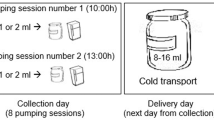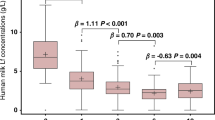Abstract
Background
Human milk vitamin B12 (B12) concentrations depend on maternal status and intake; only few data are available in high-income countries.
Objective
We assessed human milk B12 concentrations during the first 6 months postpartum in Norwegian women and its association with maternal dietary B12 intake and maternal urinary methylmalonic acid (MMA) concentration.
Methods
In this cross-sectional study, 175 mothers, exclusively (80%) or partially (20%) breastfeeding, were included. Milk B12 was measured by IMMULITE®/IMMULITE® 1000 B12 competitive protein binding assay and urinary MMA relative to creatinine (MMA/Cr) by liquid chromatography–tandem-mass spectrometry. Maternal habitual B12 intake and supplement use were estimated using a food frequency questionnaire.
Results
Mean human milk B12 concentration was 327 pmol/L (range 140–1089), with 402 pmol/L at 1 month (n = 21), 333 pmol/L at four months (n = 32), and 299 pmol/L at 6 months (n = 21). Maternal B12 intake was 5 µg/d, 89% met the Estimated Average Requirement, and supplement use did not affect milk B12 concentrations. MMA/Cr was low in all women compared with published data. In exclusively breastfeeding women, MMA/Cr (beta (95% CI) −42.5 (−82.5, −2.5) and time since birth (−4.9 (−9.6, −0.3)) were significant predictors of human milk B12 concentrations. There was no association between total B12 intake and milk B12 concentration or between total B12 intake and MMA/Cr.
Conclusions
Maternal B12 status and human milk B12 concentrations are likely sufficient, based on adequate maternal B12 dietary intake combined with low urinary MMA concentrations. Nevertheless, milk B12 concentration fell during 6 months postpartum while maternal B12 status did not change.
This is a preview of subscription content, access via your institution
Access options
Subscribe to this journal
Receive 12 print issues and online access
$259.00 per year
only $21.58 per issue
Buy this article
- Purchase on SpringerLink
- Instant access to full article PDF
Prices may be subject to local taxes which are calculated during checkout

Similar content being viewed by others
References
Dror DK, Allen LH. Overview of nutrients in human milk. Adv Nutr. 2018;9:278S–94S.
Allen LH, Miller JW, de Groot L, Rosenberg IH, Smith AD, Refsum H, et al. Biomarkers of nutrition for development (BOND): vitamin B-12 review. J Nutr. 2018;148:1995s–2027s.
Allen LH. B vitamins in breast milk: relative importance of maternal status and intake, and effects on infant status and function. Adv Nutr. 2012;3:362–9.
Molloy AM, Kirke PN, Brody LC, Scott JM, Mills JL. Effects of folate and vitamin B12 deficiencies during pregnancy on fetal, infant, and child development. Food Nutr Bull. 2008;29:101–11.
Hay G, Clausen T, Whitelaw A, Trygg K, Johnston C, Henriksen T, et al. Maternal folate and cobalamin status predicts vitamin status in newborns and 6-month-old infants. J Nutr. 2010;140:557–64.
Monsen AL, Refsum H, Markestad T, Ueland PM. Cobalamin status and its biochemical markers methylmalonic acid and homocysteine in different age groups from 4 days to 19 years. Clin Chem. 2003;49:2067–75.
Sun AL, Ni YH, Li XB, Zhuang XH, Liu YT, Liu XH, et al. Urinary methylmalonic acid as an indicator of early vitamin B12 deficiency and its role in polyneuropathy in type 2 diabetes. J Diabetes Res. 2014;2014:921616. https://doi.org/10.1155/2014/921616.
Haugen M, Brantsaeter AL, Alexander J, Meltzer HM. Dietary supplements contribute substantially to the total nutrient intake in pregnant Norwegian women. Ann Nutr Metab. 2008;52:272–80.
Hay G, Johnston C, Whitelaw A, Trygg K, Refsum H. Folate and cobalamin status in relation to breastfeeding and weaning in healthy infants. Am J Clin Nutr. 2008;88:105–14.
Henjum S, Lilleengen AM, Aakre I, Dudareva A, Gjengedal ELF, Meltzer HM, et al. Suboptimal iodine concentration in breastmilk and inadequate iodine intake among lactating women in Norway. Nutrients. 2017;9:643.
Hampel D, Shahab-Ferdows S, Domek JM, Siddiqua T, Raqib R, Allen LH. Competitive chemiluminescent enzyme immunoassay for vitamin B12 analysis in human milk. Food Chem. 2014;153:60–5.
The Norwegian Food Composition Table. The Norwegian Directorate of Health and University of Oslo. 2016. http://www.matvaretabellen.no/?language=en. Accessed 26 Apr 2017.
FoodCalc. Data Program from the Project “Diet, Cancer and Health” at the Danish Cancer Society. 2005. http://www.ibt.ku.dk/jesper/foodcalc.
TrioBe tablet. Läkemedelsverket [Swedish medical products agency]. TrioBe tablett product information in English. https://docetp.mpa.se/LMF/TrioBe%20tablet%20ENG%20PL_09001be680240cc7.pdf. Accessed 11 May 2019.
Institute of Medicine. Dietary reference intakes for thiamin, riboflavin, niacin, vitamin B6, Folate, Vitamin B12, Pantothenic Acid, Biotin, and Choline. Washington, D.C: National Academy Press; 1998.
Butte NF, Lopez-Alarcon MG, Garza C. Nutrient adequacy of exclusive breastfeeding for the term infant during the first six months of life. 2002. https://www.who.int/nutrition/publications/infantfeeding/9241562110/en/.
Nordic Council of Ministers. Nordic Nutrition Recommendations 2012 Integrating nutrition and physical activity. 5th edition. 2014. http://norden.diva-portal.org/smash/get/diva2:704251/FULLTEXT01.pdf.
Erdogan E, Nelson GJ, Rockwood AL, Frank EL. Evaluation of reference intervals for methylmalonic acid in plasma/serum and urine. Clin Chim Acta. 2010;411:1827–9.
Rasmussen K. Studies on methylmalonic acid in humans. I. Concentrations in serum and urinary excretion in normal subjects after feeding and during fasting, and after loading with protein, fat, sugar, isoleucine, and valine. Clin Chem. 1989;35:2271–6.
United Nations Development Programme. Human Development Index (HDI): United Nations Development Programme. http://hdr.undp.org/en/content/human-development-index-hdi. Accessed 15 May 2019.
Hosmer D, Lemeshow W. S. Applied Logistic Regression. New York: John Wiley & Sons; 2000.
Varsi K, Ueland PM, Torsvik IK, Bjorke-Monsen AL. Maternal serum cobalamin at 18 weeks of pregnancy predicts infant cobalamin status at 6 months—a prospective, observational study. J Nutr. 2018;148:738–45.
Greibe E, Lildballe DL, Streym S, Vestergaard P, Rejnmark L, Mosekilde L, et al. Cobalamin and haptocorrin in human milk and cobalamin-related variables in mother and child: a 9-mo longitudinal study. Am J Clin Nutr. 2013;98:389–95.
Chebaya P, Karakochuk CD, March KM, Chen NN, Stamm RA, Kroeun H, et al. Correlations between maternal, breast milk, and infant vitamin B12 concentrations among mother-infant dyads in Vancouver, Canada and Prey Veng, Cambodia: An Exploratory Analysis. Nutrients. 2017;9:E270.
Lildballe DL, Hardlei TF, Allen LH, Nexo E. High concentrations of haptocorrin interfere with routine measurement of cobalamins in human serum and milk. A problem and its solution. Clin Chem Lab Med. 2009;47:182–7.
Henjum S, Brantsaeter AL, Kurniasari A, Dahl L, Aadland EK, Gjengedal ELF, et al. Suboptimal iodine status and low iodine knowledge in young Norwegian women. Nutrients. 2018;10:941.
Neumann CG, Oace SM, Chaparro MP, Herman D, Drorbaugh N, Bwibo NO. Low vitamin B12 intake during pregnancy and lactation and low breastmilk vitamin 12 content in rural Kenyan women consuming predominantly maize diets. Food Nutr Bull. 2013;34:151–9.
Deegan KL, Jones KM, Zuleta C, Ramirez-Zea M, Lildballe DL, Nexo E, et al. Breast Milk Vitamin B-12 Concentrations in Guatemalan Women Are Correlated with Maternal but Not Infant Vitamin B-12 Status at 12 Months Postpartum. J Nutr. 2012;142:112–6.
Funding
Funded by Oslo Metropolitan University.
Author information
Authors and Affiliations
Contributions
SH, TAS, ALB, and LA designed the study. SH performed the statistical analysis, DH made Fig. 1 and MM made Table 5 and wrote parts of the discussion. ALB was in charge of the dietary assessment. DH, SS-F and NEB analyzed vitamin B12 in milk and MMA in urine. LHA and HR provided detailed feedback on the paper. All authors read and approved the final paper.
Corresponding author
Ethics declarations
Conflict of interest
The authors declare that they have no conflict of interest.
Additional information
Publisher’s note Springer Nature remains neutral with regard to jurisdictional claims in published maps and institutional affiliations.
Rights and permissions
About this article
Cite this article
Henjum, S., Manger, M., Hampel, D. et al. Vitamin B12 concentrations in milk from Norwegian women during the six first months of lactation. Eur J Clin Nutr 74, 749–756 (2020). https://doi.org/10.1038/s41430-020-0567-x
Received:
Revised:
Accepted:
Published:
Issue date:
DOI: https://doi.org/10.1038/s41430-020-0567-x



